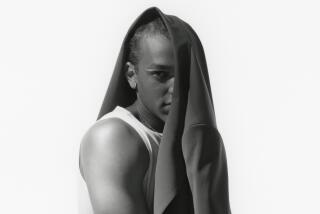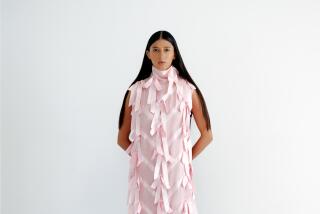The ‘90s Princess
- Share via
While many American girls spend more than 20 years fantasizing about the fairy-princess gown they hope to be married in, another kind of bride, who lives in the real world, also wants a beautiful start to living happily ever after. The practical type questions the wisdom of spending a lot of money on a dress that will be worn only once, at a time when the costs of a wedding, honeymoon and starting a new life can be considerable.
As heretical as her position might sound, the practical bride is not the anti-bride. Chances are she is every bit as romantic as her more extravagant sister, and no enemy of tradition. But she isn’t willing to mortgage the farm or ruin her credit rating to pay for her dream dress, and she takes advantage of a number of strategies for staying on a budget, including shopping for a discounted gown, buying a white dress not expressly designed for a bride or even dressing up an inexpensive bridesmaid’s dress with a headpiece, veil and a bride’s bouquet.
Emotional highs and down-to-earth prices can be in conflict. Peer pressure is another psychological force menacing the cost-conscious.
“One of my friends couldn’t stop talking about her $3,200 dress,” said Christine Franke, a development assistant for the Pasadena Symphony who was married in the spring. “I was determined to stay in the $400 range, but that didn’t mean I wasn’t as excited as she was about getting married.”
On an emotional level, skimping on the cost of a bridal gown can seem like a metaphor for not valuing the marriage that is about to begin. And the bride’s place at the epicenter of the ritual makes many women feel they’re worth it, no matter what “it” is. When a wedding is held up as the apex of female achievement, its vaunted importance gives a woman license to splurge.
“I think brides want to feel they can blow their wad and be a little crazy,” feminist author Letty Pogrebin said. “They think, ‘If not now, then when?’ Being a bride gives them the chance to be illogical, to be in charge, to spend in a kind of lunatic way. I’ve heard many women think back on it and say, ‘I can’t believe I did this. Now the dress is in a box under my bed, and I wish I had the money.’ The overspending happens because not enough women feel they have power in the rest of their lives.”
Michelle Kessler is the quintessential happy, practical bride. With her long, sun-streaked brown hair and athletic body, she’d make any “Melrose Place” casting director’s head turn. A marketing executive for a fashion company in New York, Kessler bought her unconventional wedding dress soon after she became engaged.
“I walked into the Calvin Klein boutique on Madison Avenue because I love the simplicity of his dresses,” she said. “My personal style is not to be dressed up. I wouldn’t feel comfortable in anything elaborate or fussy. I never went into a bridal store, and not because I didn’t think I could find something simple. But something simple at Vera Wang would cost me $8,000. I’m 31, and the whole fantasy of the big cake and all the people has worn off for me. I’m more focused on the marriage, and, at my age, you start thinking about how you’ll pay tuition for the children you’re going to have.”
For her summer wedding, she chose a long, white, sleeveless linen dress lined in silk.
“I took it off the rack, tried it on, they pinned the hem up a little, and that was it. It cost $800, and I won’t wear a veil. If I wear any jewelry at all, it’ll just be little diamond stud earrings. My goal was to find something simple, elegant and comfortable that I could wear again and that I would feel like myself in. I didn’t want to look like I could be popped onto the top of a cake.”
Simplicity has been the most significant bridal styling trend of the decade. When Carolyn Bessette Kennedy married John F. Kennedy Jr. wearing a plain, bias-cut gown two years ago, instead of being in the vanguard, she merely personified the no-frills look brides had been favoring for years. But simplicity doesn’t necessarily come cheap.
“Ironically, the more expensive a gown is, the simpler it will often be,” said Renee Strauss, who owns Renee Strauss for the Bride in Beverly Hills. “A woman who pays $5,000 to $10,000 for a gown is paying for a designer label and often for custom details like a longer train or a detachable train. In general, you expect that the styling of the more costly gowns would be better, and that’s what you’re getting for your money, but there are exceptions.”
Fine lace and hand beading can drive up the price of a wedding gown, but, since plain is in, women like Michelle Kessler opt for any white dress that pleases them. Although the Morgane Le Fay boutique in Santa Monica doesn’t only sell wedding gowns, it does have a few gorgeous, simple ones every season. Some smart brides have taken advantage of the fact that Morgane Le Fay designer Liliana Casabal has a talent for creating feminine, ethereal evening dresses devoid of frou frou. When those dresses come in white or champagne, they can provide an alternative that costs a fraction of the gowns specifically designed for brides.
The “wear it again” factor goes up considerably with a dress like the $495 bias-cut gown Les Habitudes makes in white crushed velvet or ivory satin. Most of the beaded, corset-topped gowns at Les Habitudes sell for $3,000 to $6,000. But the store operates an annex for markdowns.
At Les Habitudes Bis around the corner, merchandise is half off or more. A corset marked down to $900 could be paired with an inexpensive satin, chiffon or crepe skirt to create the romantic look in which the boutique has dressed many a bride.
Gowns that look as if they weren’t meant for Snow White are favorites of older brides. Barbra Streisand wanted the whole fairy tale for her summer wedding, but many women marrying for the second or third time feel foolish in conventionally dreamy gowns.
“You don’t need to spend $5,000 for tradition,” Pogrebin points out. “If you’re the only one with a pouf on your head wearing a white dress, you’re going to look like the bride. Carry some calla lilies, and you’re a bride.”
Dressing Up a Bridesmaid’s Gown
Renee Strauss suggests that a woman who’s considering wearing an inexpensive bridesmaid’s dress instead of a wedding gown try it on with a veil to get the full effect. Well-made bridesmaid’s dresses range from $160 to $350. They don’t come with trains, which can be a liability or a benefit, depending on how formal the wedding will be and how much the bride likes to dance.
“Even though they’re not expensive, some bridesmaid’s dresses are made of beautiful fabrics like silk chiffon,” Strauss said. Most samples are in color, so a bride has to imagine how she will look if the same dress is made for her in white or ivory.
The most inveterate bargain hunter often balks at shopping for a cut-rate wedding gown. But because no caption runs under the wedding picture saying, “This dress was bought on sale,” who’s to know? Most bridal boutiques have sale racks where sample size 10s, the equivalent of a size 8 in a regular dress, are discounted from 20% to as much as 75%. A store will mark down a sample because the style has been discontinued by the manufacturer, the fit is poor on most bodies, or it has been a slow seller and getting rid of it will make room for a potentially more popular style. Another way to save money is to hunt for accessories on sale. The costs of a veil, headpiece and shoes can add up.
It would be surprising if the bridal industry were the only segment of the clothing business in which consumers couldn’t buy at a discount. In fact, Price Less Warehouse in Canoga Park is to bridal gowns what Loehmann’s is to regular clothes--a place where manufacturer’s overruns and unsold merchandise from stores that want to unload old inventory is offered at substantial discounts.
“I carefully buy irregulars, manufacturers’ samples, runway samples and the stock of stores going out of business,” said owner Twyla Martin. She originally opened her shop in a discount mall as an outlet for her bridal manufacturing company, then kept the store when she shut down her wholesale business five years ago. Most gowns in the store are priced under $600, and even current styles are discounted 15%.
Some are discounted much more. A gown acquired from a bridal boutique in Pittsburgh that went out of business originally cost $1,495. It is marked down to $299. A $2,400 gown that once hung in a South Carolina shop is also tagged $299.
Martin has learned that brides seldom brag about the bargains they find.
“No matter what a girl spends on a dress,” she says, “when her girlfriends ask her how much it cost, she lies.”
*
Credits for lead Bridal Story:
Hair and makeup by Kim Goodwin for Cloutier.
Photographed at the Sunset Marquis Hotel & Villas.
Styling by Laura Goldsmith and Mimi Avins.
(BEGIN TEXT OF INFOBOX / INFOGRAPHIC)
Resources
* Renee Strauss for the Bride, 8692 Wilshire Blvd., Beverly Hills, (310) 657-1700.
* Les Habitudes, 101 N. Robertson Blvd., Los Angeles, (310) 273-2883, and 8644 Sunset Blvd., West Hollywood,
(310) 659-2906.
* Les Habitudes Bis, 8811 Alden Drive, Los Angeles, (310) 273-2624.
* Morgane le Fay, 1528 Montana Ave., Santa Monica, (310) 393-4447.
* ABS, 1533 Montana Ave., Santa Monica, (310) 393-8770, and 55 W. Colorado St., Pasadena,
(626) 577-8505.
* Price Less Bridals, Fallbrook Mall, 6633 Fallbrook and Victory boulevards, Canoga Park, (818) 340-6514.
* Jennifer Kaufman at the Beverly Center, Los Angeles, (310) 854-1058.
* Rita Flora 468 S. La Brea Ave., Los Angeles, (213) 938-3900.






